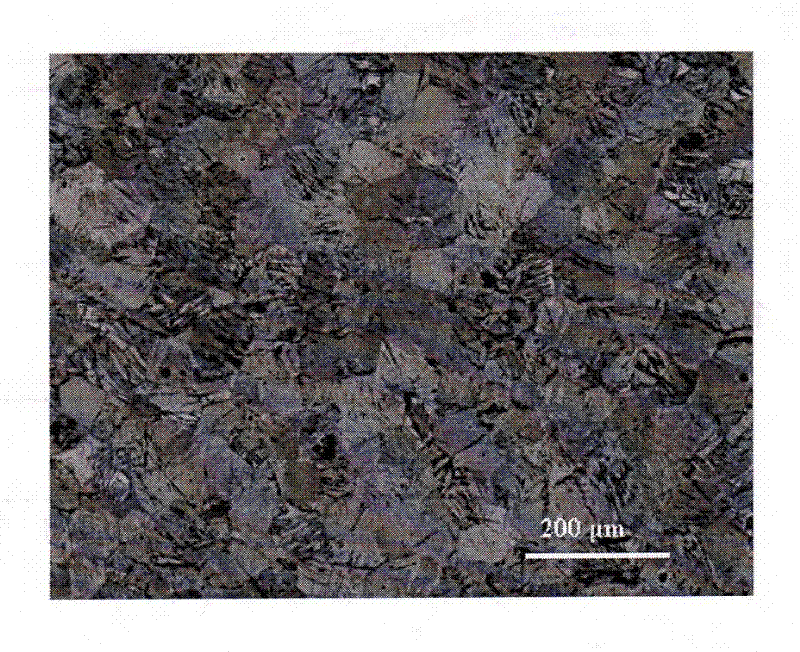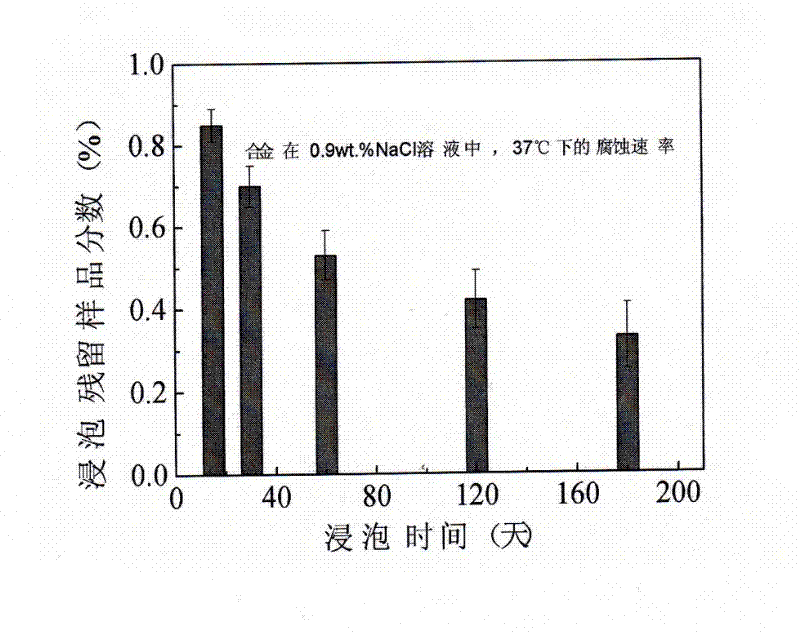A biodegradable magnesium-based orthopedic implant biomedical material and preparation method thereof
A biomedical material and orthopaedic technology, applied in medical science, prosthesis, etc., can solve the problems that pure magnesium is difficult to meet the mechanical conditions of implant materials, difficult to apply for clinical use of the US FDA, lack of international evaluation standards, etc., and achieve metabolic pathway. Clear, non-toxic and side effects, eliminating the effect of primary battery corrosion
- Summary
- Abstract
- Description
- Claims
- Application Information
AI Technical Summary
Problems solved by technology
Method used
Image
Examples
Embodiment 1
[0020] Take 30 grams of Zn grains with a mass purity of 99.99%, 1 g of Ca grains, and 20 grams of Ag grains, all of which have a particle size of 200 mesh; the remainder is Mg ingots with a mass purity of 99.9%, and remove the surface scale of the Mg ingots. All added raw materials were preheated at 400°C for 90 minutes, metal Mg ingots, Zn grains, Ca grains, and Ag grains were added in sequence to a tantalum crucible at 770°C, protected by a 1:15 mixture of sulfur hexafluoride and argon, and prepared Alloy ingot; each time a raw material is added, stir for 30 minutes. After all the raw materials are added, stir for 50 minutes and stop heating. The alloy liquid is poured into the steel mold at 770°C, and the steel mold is fully preheated at 700°C. After pouring, it is kept in a resistance furnace for 60 minutes, and then cooled to room temperature with water to obtain the composition: Mg-3Zn-0.1Ca-2Ag (wt.%) 1000 g alloy ingot; the above alloy ingot was preheated at 200°C for ...
Embodiment 2
[0024] Take 1 g of Zn grains with a mass purity of 99.99%, 30 g of Ca grains, and 0.1 g of Ag grains, all of which have a particle size of 200 mesh, and the remainder is Mg ingots with a mass purity of 99.9%, and remove the surface scale of the Mg ingots. After all the added raw materials were preheated at 200°C for 30 minutes, metal Mg ingots, Zn grains, Ca grains, and Ag grains were added to the tantalum crucible at 770°C in sequence. Prepare the alloy ingot under the protection of a 1:12 mixture of sulfur hexafluoride and argon; each time a raw material is added, stir for 10 minutes, after all the raw materials are added, fully stir for 20 minutes, and pour it into a steel mold at 700 ° C. The steel mold was preheated at 600 °C, and after pouring, it was kept in a resistance furnace for 30 minutes, and then cooled to room temperature with water to obtain a 1000 g alloy ingot with the composition: Mg-0.1Zn-3Ca-0.01Ag (wt.%); the above The alloy ingot was preheated at 400°C f...
Embodiment 3
[0028]Take 10 grams of Zn grains with a mass purity of 99.99%, 20 grams of Ca grains, and 10 grams of Ag grains, all of which have a particle size of 200 mesh, and the balance is Mg ingots with a mass purity of 99.9%, and remove the surface scale of the Mg ingots. After all the added raw materials were preheated at 300°C for 50 minutes, metal Mg ingots, Zn grains, Ca grains, and Ag grains were added to the tantalum crucible at 770°C in sequence. Prepare the alloy ingot under the protection of a mixed gas of sulfur hexafluoride and argon at a ratio of 1:10; stir for 25 minutes each time a raw material is added, and fully stir for 40 minutes after all the raw materials are added, and pour it into a steel mold at 720 ° C. The steel mold was preheated at 650 °C, and after pouring, it was kept in a resistance furnace for 50 minutes, and then cooled to room temperature with water to obtain a 1000 g alloy ingot with the composition: Mg-1Zn-2Ca-1Ag (wt.%); the above alloy ingot Prehea...
PUM
 Login to View More
Login to View More Abstract
Description
Claims
Application Information
 Login to View More
Login to View More - Generate Ideas
- Intellectual Property
- Life Sciences
- Materials
- Tech Scout
- Unparalleled Data Quality
- Higher Quality Content
- 60% Fewer Hallucinations
Browse by: Latest US Patents, China's latest patents, Technical Efficacy Thesaurus, Application Domain, Technology Topic, Popular Technical Reports.
© 2025 PatSnap. All rights reserved.Legal|Privacy policy|Modern Slavery Act Transparency Statement|Sitemap|About US| Contact US: help@patsnap.com



